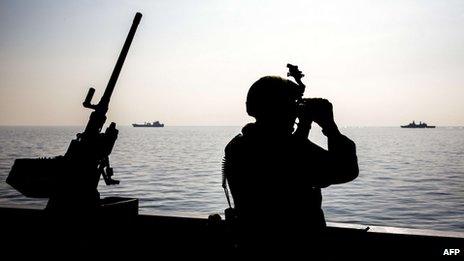Syria chemical weapons: Security 'slows transport'
- Published
Ahmet Uzumcu: "We want to meet the deadline... but we have to recognise there are challenges"
The head of the UN body tasked with removing and destroying Syria's chemical arsenal says the process has been slowed down by security concerns.
Ahmet Uzumcu said the amount removed so far was not that high but expressed confidence the June deadline for destroying the chemicals would be met.
Removing the most dangerous chemicals is the first step of a UN-backed deal to eliminate Syria's chemical arsenal.
The US has meanwhile urged Syria's opposition to attend peace talks.
The main political opposition movement, the Syrian National Coalition, will meet in Istanbul on Friday to vote on whether to attend the "Geneva II" talks, scheduled to take place in Switzerland next week but which have been dogged by setbacks.
US Secretary of State John Kerry said the US "urges a positive vote", saying it was "important there be no games played with this process".
Mr Kerry reiterated that the aim of the talks is to end the conflict by establishing a transitional government by mutual consent.
'Accidents possible'
The UN's Organisation for the Prohibition of Chemical Weapons (OPCW) has a deadline of 31 March for Syria's most dangerous poison gas and nerve agents to be removed from the country.
The stockpile is to be destroyed by 30 June.
Speaking earlier in Rome, Mr Uzumcu said their removal had been it by delays caused by technical problems and the obvious difficulties of operating in a warzone.
But he said additional measures had been put in place to help smooth the process, and that the OPCW would "do our best to meet" the end of June deadline.

The chemical weapons are due to be destroyed in international waters
The Syrian authorities are responsible for packing and safely transporting the chemical weapons to Latakia.
Denmark and Norway are providing cargo ships and military escorts to take them to Italy, where they will loaded onto a US Maritime Administration cargo ship, MV Cape Ray.
The materials be destroyed in international waters by a process known as hydrolysis.
On Thursday, Italian Transport Minister Maurizio Lupi confirmed that the ship-to-ship transfers will take place at its southern port of Gioia Tauro, stressing they would follow international safety standards and that none of the cargo would come ashore.
But the town's Mayor Renato Bellofiore told the BBC he had not been consulted over the plan.
"We are extremely worried. An accident may be unlikely, but it is not impossible," he said, accusing the UN of making his town "a dumping ground".
International outrage
Syria continues to be ravaged by the conflict which began with the uprising against President Bashar al-Assad in March 2011.
The decision on Syria's chemical weapons stockpile arose from confirmation of a sarin attack in Damascus on 21 August.
It killed hundreds, provoked international outrage and led to a US-Russia deal to destroy the weapons.
The UN says more than 100,000 people have died since the Syrian conflict began. An estimated two million people have fled Syria and some 6.5 million have been displaced internally.
How the plan will unfold

1. The Syrian authorities are responsible for packing and safely transporting the chemical weapons from 12 sites across the country to the port of Latakia. Russia has supplied large-capacity and armoured lorries, while the US has sent container drums and GPS locators.
2. Russia is providing security for loading operations at Latakia, for which the US has supplied loading, transportation and decontamination equipment. China has sent 10 ambulances and surveillance cameras, and Finland an emergency response team in case of accidents.
3. Denmark and Norway are providing cargo ships and military escorts to take the chemicals to the container port of Gioia Tauro in Italy. Russia and China are also providing naval escorts and the first consignment of 16 tonnes left Latakia on 7 January.
4. In Italy, the "most critical" chemical agents will be loaded onto the US Maritime Administration cargo ship, MV Cape Ray, to be destroyed by hydrolysis in international waters. Less-toxic chemicals will be shipped by Norwegian and Danish vessels for disposal at commercial facilities.